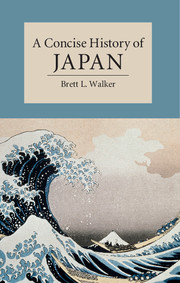Book contents
- Frontmatter
- Dedication
- Contents
- List of Illustrations
- List of Maps
- Preface
- Chronology
- Introduction
- 1 The Birth of the Yamato State, 14,500 bce – 710 ce
- 2 The Courtly Age, 710–1185
- 3 The Rise of Samurai Rule, 1185–1336
- 4 Medieval Japan and the Warring States Period, 1336–1573
- 5 Japan’s Encounter with Europe, 1543–1640
- 6 Unifying the Realm, 1560–1603
- 7 Early Modern Japan, 1600–1800
- 8 The Rise of Imperial Nationalism, 1770–1854
- 9 Meiji Enlightenment, 1868–1912
- 10 Meiji’s Discontents, 1868–1920
- 11 The Birth of Japan’s Imperial State, 1800–1910
- 12 Empire and Imperial Democracy, 1905–1931
- 13 The Pacific War, 1931–1945
- 14 Japan’s Post-War History, 1945–Present
- 15 Natural Disasters and the Edge of History
- Glossary
- Further Reading
- Index
14 - Japan’s Post-War History, 1945–Present
Published online by Cambridge University Press: 05 March 2015
- Frontmatter
- Dedication
- Contents
- List of Illustrations
- List of Maps
- Preface
- Chronology
- Introduction
- 1 The Birth of the Yamato State, 14,500 bce – 710 ce
- 2 The Courtly Age, 710–1185
- 3 The Rise of Samurai Rule, 1185–1336
- 4 Medieval Japan and the Warring States Period, 1336–1573
- 5 Japan’s Encounter with Europe, 1543–1640
- 6 Unifying the Realm, 1560–1603
- 7 Early Modern Japan, 1600–1800
- 8 The Rise of Imperial Nationalism, 1770–1854
- 9 Meiji Enlightenment, 1868–1912
- 10 Meiji’s Discontents, 1868–1920
- 11 The Birth of Japan’s Imperial State, 1800–1910
- 12 Empire and Imperial Democracy, 1905–1931
- 13 The Pacific War, 1931–1945
- 14 Japan’s Post-War History, 1945–Present
- 15 Natural Disasters and the Edge of History
- Glossary
- Further Reading
- Index
Summary
Japan emerged from the Pacific War in tatters, but the small island country, showing Meiji-era resolve and with US support, quickly began rebuilding. By the 1950s, Japan had entered the era of ‘high speed growth’ and washing machines, refrigerators, and televisions, the ‘three sacred jewels’ of post-war consumerism, started to inhabit most Japanese homes, or at least most consumer imaginations, brightening once-glum lives. Government agencies, working in tandem with corporations and labour, and sheltered by the US security umbrella, orchestrated the economic recovery that birthed such global powerhouses as Toyota Motor Corporation and Sony. Politically, the conservative Liberal Democratic Party dominated the Diet for decades. It revised US occupation reforms and later pushed for constitutional changes, as well as further privatization of the economy. But as Japan entered the 1970s, environmental pollution tainted its celebrated economic success. Although the ‘big four’ pollution cases of Niigata and Minamata methyl-mercury poisoning, Yokkaichi asthma, and cadmium poisoning in Toyama stole most national and international headlines, smaller, equally devastating pollution problems occurred wherever industrial development went unchecked. In the name of the post-war economic recovery, which preoccupied Japanese politics for decades, the nation appeared willing to poison its most vulnerable people and environments.
If Japan’s manufactured exports, ranging from the Toyota Corona to the Sony Walkman, characterized the decades after the Pacific War, pop culture exports have characterized recent decades. Whether in the urban exploits of Godzilla or the animated films of Miyazaki Hayao (b. 1941), Japan’s cultural production reflects many Japanese anxieties about nuclear warfare and industrial pollution. But Japan has emerged as a major exporter of culture. Today, the island nation is as much celebrated for its graphic novels as it is for the ‘sacred war’ it fought against the US and its staggeringly successful post-war economy.
- Type
- Chapter
- Information
- A Concise History of Japan , pp. 261 - 282Publisher: Cambridge University PressPrint publication year: 2015



